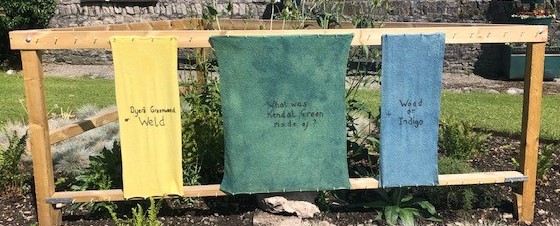1390-1767
Location – By Shap Road outside Kendal Cricket Ground.
“Kendal Green” was a coarse cloth worn by peasants and legendary rascals such as Robin Hood’s outlaws and Shakespeare’s “misbegotten knaves”. It made the town rich and famous. Kendal had an abundance of the natural resources needed to make the cloth: wool from sheep; soap from bracken; plenty of water for washing, fulling and dyeing; fuller’s teasels for raising the nap on the cloth; dye producing plants; and plenty of enterprising people to bring it all together.
We don’t know exactly how “Kendal Green” was made. In this display we’ve made a small tenterframe on which unfinished cloth can be dried and stretched between two rows of tenterhooks. In years past, miles of these covered fields in and around the Town. Inside our tenterframe we’ve put the Dyers’ greenweed and weld used to dye the cloth yellow before blue dye from woad or indigo turned it green. The story of “Kendal Green” was also linked to big changes in the Kendal landscape. We’ve planted ferns to represent the woodlands that were common in the landscape before over-grazing by sheep created the rocky grass-dominated fells that surrounded the town in the 18th century.
Things to Ponder
1. Was the making of “Kendal Green” “green” in a modern sense of the word? “Kendal Green” was the basis for the social and economic development of the town – but was it good or bad for the landscape and environment?
2. What colour was “Kendal Green” and how was it made? One way we might better understand how “Kendal green” was made is through a process known as “experimental archaeology” in which we explore and recreate the ways people may have done everyday things in the past. We asked a local amateur artisan, Irene Wrigley, to have a go at making some Kendal Green cloth and explain what she learned in the process. Here’s how Irene described her first attempt to produce the “yellow”, “blue” and “Kendal Green Cloth” you can see on the photo of our tenterframe as it looked in July 2021:

“The first step was to use a mordant to help fix the dye in the cloth. I used an old woollen blanket and mordanted by boiling it in a weak solution of Alum (Aluminium sulphate) for about 45 minutes.
To produce the yellow cloth I used a dye from weld ( Reseda luteola ). It is thought that originally the yellow dye came from Dyer’s Greenweed (Genista Tinctoria) which was found locally around the Town but later weld was used as it was longer lasting. I grew some weld in my garden. To produce the dye, I simply chopped the weld leaves, flowers and stalks up into small pieces and put them in a large pan of water which I boiled and simmered for an hour. The next day I drained off the liquid into another pan where the cloth was added, brought to the boil and then left for several hours. On removing the cloth, it was then a lovely bright yellow.
Originally woad was probably used to produce the blue cloth, but from the 16th century indigo was imported from abroad. The next part of my process was to make an indigo vat which requires indigo (Indigofera tinctoria), sodium hydrosulphite and soda ash. It is an exciting process and when you take the cloth out of the vat it is yellow, but as it is exposed it oxidises in the air and goes blue. To get darker blue I dipped it several times in the vat.
For the final stage to get the “Kendal Green” cloth, I simply dipped one of the yellow pieces I had dyed with weld into the indigo vat and this then turned “Kendal Green”.
But there was a problem. When I first dyed the cloth I used dried weld and indigo. But once this was exposed to the sun it quickly lost most of the yellow from the weld leaving just the longer lasting blue colour from the indigo. This also explains why in old tapestries the trees and bushes look blue – it’s because the yellow dye from the dyeing process has disappeared just leaving the blue from indigo. In the past, I think the dyers of “Kendal Green” cloth would also have experimented with amounts of dye materials and the lengths of time the cloth was dyed for, to get a fairly uniform colour of “Kendal Green”, but maybe different dyers had their own recipes, so there probably was a small range in the shade of Kendal Green.
So I tried again a second time. This time I used fresh weld from my garden and much more of it, so when I dyed the cloth with weld it was much brighter yellow, and the one overdyed in indigo was a bright ’Kendal Green’. Hopefully it will be more long lasting although inevitably it will fade being outside in full sun!“
What’s in the display and why?

